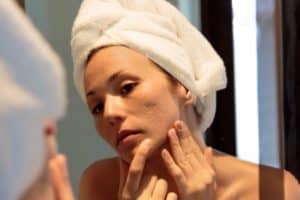When acne is finally gone, many of us are left with the consequences of this inflammatory condition.
These consequences may appear in the form of hyperpigmentation, uneven skin tone, post-inflammatory redness, uneven texture, bumpy skin, pitted or raised scarring, etc.
Fortunately, most of the damage left from acne is treatable; however, it should go without saying that you will need patience, the right treatments, proper nutrition, some professional help, and most importantly – taking great care of your skin while it’s healing.
But with all that in mind, you also need to understand your scarring in order to know how to treat it.
This is why, in this article, we will be discussing the different types of acne scarring and how to identify them, as well as what are the best treatments for every type of acne scar.
And without any further ado, here are the most common types of acne scarring:
Post-Inflammatory Hyperpigmentation
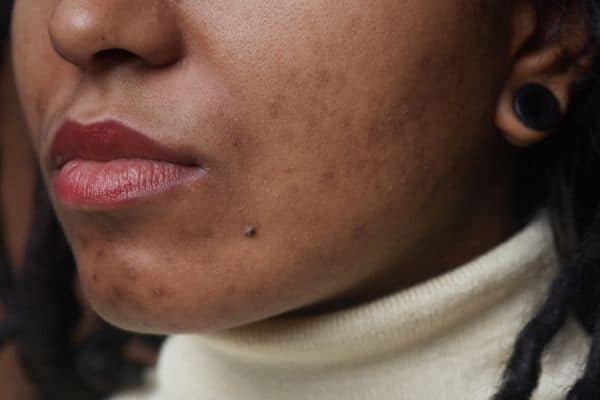
Post-inflammatory hyperpigmentation is discoloration left on the skin after a pimple has healed.
Hyperpigmentation most commonly manifests itself as dark or brown spots, but it can vary in color, depending on your skin tone.
How Does Post-Inflammatory Hyperpigmentation Develop?
Post-inflammatory hyperpigmentation is the result of your body’s natural inflammatory response to acne.
During this response, your body produces more melanin (the brown pigment that gives skin its color) in order to heal the acne lesions.
This uneven production of melanin results in uneven color and darker patches than the surrounding area.
Best Topical Treatments for Post-Inflammatory Hyperpigmentation
The best way to treat post-inflammatory hyperpigmentation scars with topical products is to use agents known as melanin-inhibitors. If you are looking to treat pure discoloration from hyperpigmentation you need to focus on topical agents that nourish the skin barrier.
These components work by blocking the enzyme tyrosinase, which is found inside melanocyte cells and is responsible for the production of melanin.
Some of the most effective melanin-inhibitors found in topical products are:
- Hydroquinone
- Kojic acid
- Tranexamic acid
- Azelaic acid
- Retinoids
- Arbutin
- Niacinamide
In addition to that, you can also use topical treatments that contain exfoliating acids as these will help slough off the dead skin cells that are trapping the melanin underneath and help renew the skin by shedding the pigmented areas.
The best exfoliating acids for post-inflammatory hyperpigmentation are:
- Glycolic acid
- Lactic acid
- Mandelic acid (If you are interested, The Ordinary has a great Mandelic Acid serum for dry skin.)
However, it is important to note that these ingredients can make the skin more sensitive to the sun, so be sure to use sunscreen every day once you introduce them into your daily routine.
Best Professional Treatments for Post-Inflammatory Hyperpigmentation
When it comes to professional treatments, there are a few options that can be effective in treating post-inflammatory hyperpigmentation.
These include:
- Chemical peels
- Microdermabrasion
- Laser therapy
- Intense pulsed light therapy (IPL)
In general, chemical peels and microdermabrasion are more effective in treating mild to moderate cases of post-inflammatory hyperpigmentation while laser therapy and intense pulsed light therapy are better suited for treating more severe cases.
Post-Inflammatory Erythema
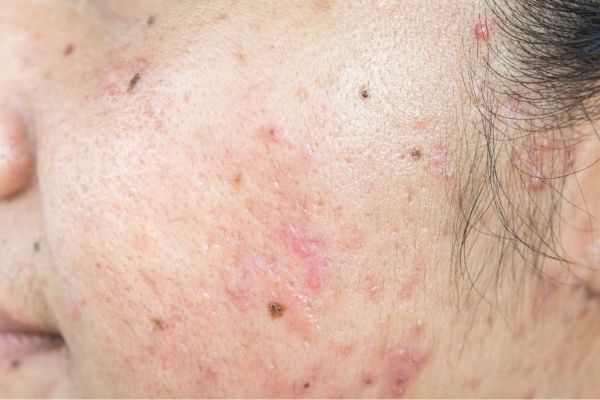
Post-inflammatory erythema is often confused with post-inflammatory hyperpigmentation; however, instead of dark and brown spots, this form of acne scarring manifests itself as redness and blotchiness on the skin.
How Does Post-Inflammatory Erythema Develop?
Post-inflammatory erythema is the result of damaged blood vessels during the inflammatory response to acne.
Severe trauma to the skin causes the delicate capillaries under our skin to break, which triggers an increase in blood flow to heal the vascular wound.
Post-inflammatory erythema is more prominent in lighter skin tones and typically takes longer to heal than post-inflammatory hyperpigmentation.
Best Topical Treatments for Post-Inflammatory Erythema
The best way to treat post-inflammatory erythema is to use topical products that contain anti-inflammatory and soothing agents.
Some of the most effective ingredients for treating post-inflammatory erythema are:
- Green tea extract
- Chamomile extract
- Licorice root extract
- Colloidal oatmeal
- Niacinamide
- Azelaic acid
These ingredients work by calming the skin, repairing the skin barrier, and reducing inflammation, which will eventually help repair the broken capillaries.
In addition to that, retinoids can also help improve post-inflammatory erythema by stimulating collagen production and increasing cell turnover, which helps repair the skin.
Best Professional Treatments for Post-Inflammatory Erythema
When it comes to professional treatments, there are a few options that can be effective in treating post-inflammatory erythema.
These include:
- Laser therapy
- Intense pulsed light therapy (IPL)
- Microneedling
- Microchanneling
- Radiofrequency therapy
In general, laser therapy and intense pulsed light therapy are more effective in treating more severe cases of post-inflammatory erythema while micro-needling, micro channeling, and radiofrequency therapy are better suited for treating mild to moderate cases.
Ice Pick Acne Scar
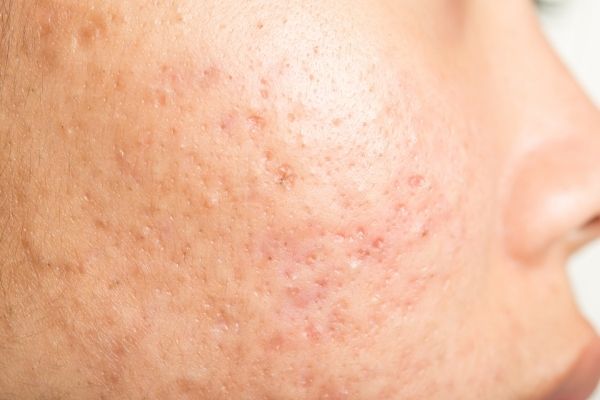
Ice pick acne scars are small, narrow scars that look like an enlarged pore.
However, even though they look the least menacing compared to other types of atrophic acne scarring, ice pick scars are actually the most challenging to treat because they can go very deep into the skin.
How Do Ice Pick Acne Scars Develop?
Ice pick acne scars develop due to deeper acne breakouts, such as cysts and nodules that have remained on the skin for a longer time.
Deep cystic acne can damage the tissue beneath the visible skin layer, and with not enough collagen to fill up these spots, we are left with noticeable pits and depressions in the skin.
Best Topical Treatments for Ice Pick Acne Scars
Because ice pick acne scars go deeper into the skin, not many skincare products can actually help target the root of the issue.
However, some ingredients that stimulate collagen production might help improve their appearance over time.
Here are some of them:
- Retinoids
- Glycolic acid
- Vitamin C
- Hyaluronic acid
Best Professional Treatments for Ice Pick Acne Scars
When it comes to professional treatments, there are a few options that can be effective in treating ice pick acne scars.
These include:
- Laser therapy
- Microneedling
- Microchanneling
- Subcision
- Dermal fillers
- Punch grafting
- Dermabrasion
- Microdermabrasion
In general, laser therapy, microneedling, microchanneling, subcision, and punch grafting are more effective in permanently removing more severe cases of ice pick acne scars while dermabrasion, microdermabrasion, and fillers are better suited for treating mild to moderate cases in smaller areas.
Boxcar Acne Scars
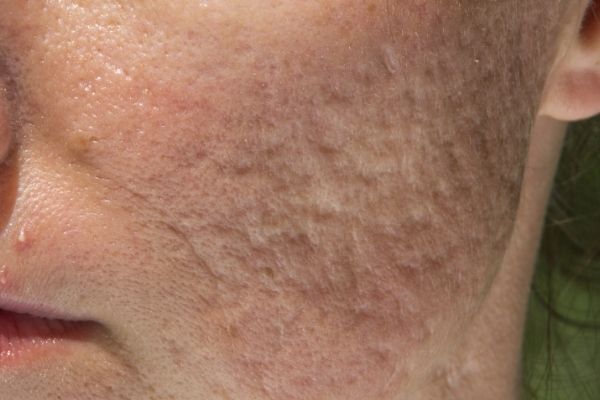
Boxcar acne scars are a type of atrophic scar, meaning that the base of the scar sits lower than the surface of the surrounding skin.
How Do Boxcar Acne Scars Develop?
Boxcar acne scars result from the loss of collagen and elastin during the healing process.
Best Topical Treatments for Boxcar Acne Scars
Although boxcar acne scars are more shallow than ice pick scars, their base still lies deeper than the surrounding skin; therefore, they can’t be fully treated with only topical products.
Retinoids can help as these work by increasing cellular turnover and stimulating collagen production, but they are unlikely to fully get rid of boxcar scarring without any professional treatments.
With that said, the two most effective retinoids that will help improve the appearance of boxcar scars are:
- Adapalene
- Tretinoin
Best Professional Treatments for Boxcar Acne Scars
Boxcar scars generally respond better to professional treatments, and luckily there are many options that can improve their appearance and fully get rid of them.
These include:
- Laser therapy
- Microneedling
- Microchanneling
- Subcision
- Punch grafting
- Dermal fillers
- TCA Cross (chemical reconstruction of skin scars)
In general, laser therapy, micro-needling, micro channeling, subcision, and punch grafting are more effective in treating more severe cases of boxcar acne scarring, while TCA cross and dermal fillers are better suited for treating mild to moderate cases in smaller areas.
Rolling Acne Scars
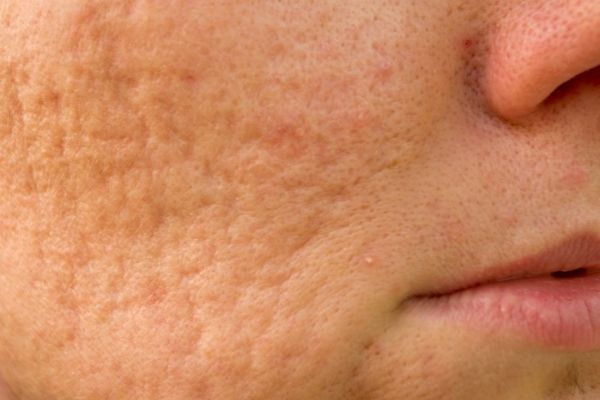
Rolling acne scars are the least severe type of atrophic scarring and appear as hallow indentations with no distinct edges that give the skin a wave-like appearance.
How Do Rolling Acne Scars Develop?
Rolling acne scars, just like boxcar and ice pick scars, are the result of a loss of collagen and elastin in areas where acne and inflammation were severe.
Best Topical Treatments for Rolling Acne Scars
Rolling scars are more shallow than boxcar scars and thus might respond better to topical treatments.
Some products that might help improve or fully get rid of rolling acne scars are:
- Retinoids
- Glycolic acid
- Lactic acid
Best Professional Treatments for Rolling Acne Scars
Rolling acne scars are likely to respond best to a variety of professional treatments and usually require fewer sessions than other types of atrophic acne scarring.
Some helpful treatments for rolling acne scars include:
- Microneedling
- Microchanneling
- Laser therapy
- Subcision
- Punch grafting
- Dermal fillers
- TCA Cross (chemical reconstruction of skin scars)
In general, micro needling, micro channeling, laser therapy, and subcision are more effective in treating more severe cases of rolling acne scarring while TCA cross, punch grafting, and dermal fillers are better for mild to moderate cases.
Hypertrophic Acne Scars
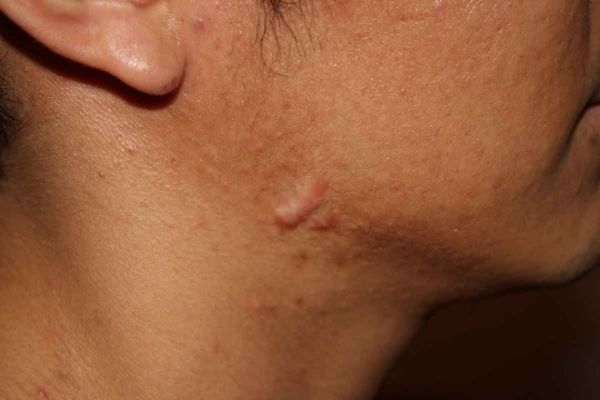
Hypertrophic acne scars are raised, thickened scars that are often discolored, pinkish, or darker than the surrounding area.
They can sometimes be itchy or painful and might feel hard to the touch.
How Do Hypertrophic Acne Scars Develop?
Hypertrophic acne scars develop when the body produces an abnormal amount of collagen tissue in an attempt to heal an injury.
When a deeper wound is formed due to some kind of skin trauma, the base would go all the way down into the dermis and trigger the myofibroblasts, which are cells that produce collagen, into repair mode.
This can sometimes lead to extra tissue production, which appears on the skin as a raised, hypertrophic scar that usually looks more severe than the original injury.
Hypertrophic scars are usually caused by severe acne, surgery, or injuries such as cuts, scrapes, scratches, and burns.
Best Topical Treatments for Hypertrophic Acne Scars
Hypertrophic acne scars can’t be fully treated with topical products, however, they can be softened and improved with certain ingredients.
Some helpful topical treatments for hypertrophic acne scars are:
- Rosehip oil
- Squalane
- Retinoids
- Glycolic acid
- Lactic acid
- Silicone sheets
Oils can do a good job in softening the scar and making it appear less pronounced while retinoids and exfoliating acids can shed the surface layers of dead skin and flatten the hypertrophic scar over time.
Best Professional Treatments for Hypertrophic Acne Scars
Hypertrophic acne scars respond best to professional treatments, and although results can be seen almost immediately, it will likely take more than one session to fully get rid of the scarring.
Some helpful professional treatments for hypertrophic acne scars are:
- Corticosteroids
- Laser therapy
- Cryotherapy
- Bleomycin
- Dermabrasion
- Microdermabrasion
- Surgical removal
Laser therapy is by far the most effective treatment on this list, and although costly, the results are always satisfactory.
Corticosteroids, cryotherapy, and Bleomycin can also help flatten the scars, while dermabrasion and microdermabrasion can help even out the skin’s surface.
Surgical removal is a last resort option and should only be considered for large hypertrophic scars that haven’t responded to other treatments.
Keloids
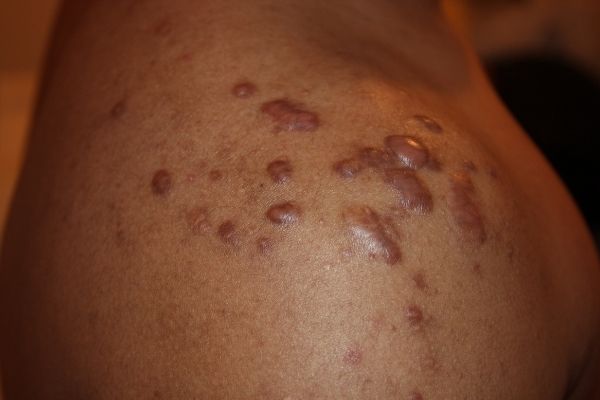
Keloids are the most severe form of a hypertrophic scar and these lesions are characterized by an abnormally large overgrowth of collagen tissue that’s even bigger than the initial injury.
Keloids can also change their color and usually appear brownish, purple, or pinkish, and this happens because they contain more blood vessels than other types of scars.
Although relatively unproblematic keloids can sometimes be itchy and uncomfortable due to their size.
How Do Keloids Develop?
Keloids and hypertrophic scars may be different in appearance but they are essentially a result of the same chemical reaction which triggers abnormal production of collagen tissue in response to injury that leads to the scar continuing to grow even after the injury has healed.
Keloids are more likely to develop on the chest, shoulders, upper back, arms, or earlobes, and people with darker skin tones are more susceptible to experiencing this occurrence.
Best Topical Treatments for Keloids
Much like with atrophic scarring, keloids can be improved with some topical products but they generally respond better to professional treatments.
Here are some topical products that can help soften and improve the appearance of keloids:
- Rosehip oil
- Squalane
- Vitamin E oil
- Retinoids
- Lactic acid
- Silicone gels and sheets
Best Professional Treatments for Keloids
If you want to get rid of your keloid for good, then professional treatments are definitely the way to go.
Here are some helpful, professional treatments for keloids:
- Corticosteroids
- Cryotherapy
- Laser therapy
- Bleomycin
- Surgical removal
Corticosteroids and Bleomycin are typically injected into the center of the keloid to help reduce its size and are considered the most effective keloid treatments.
Laser therapy, on the other hand, can help in flattening the scar and evening out the skin’s surface.
Cryotherapy is another popular treatment that involves freezing the keloid with liquid nitrogen to help destroy the extra collagen tissue.
Surgical removal is usually the last resort option, but it’s effective in getting rid of large keloids for good, while leaving minimal scarring behind.
